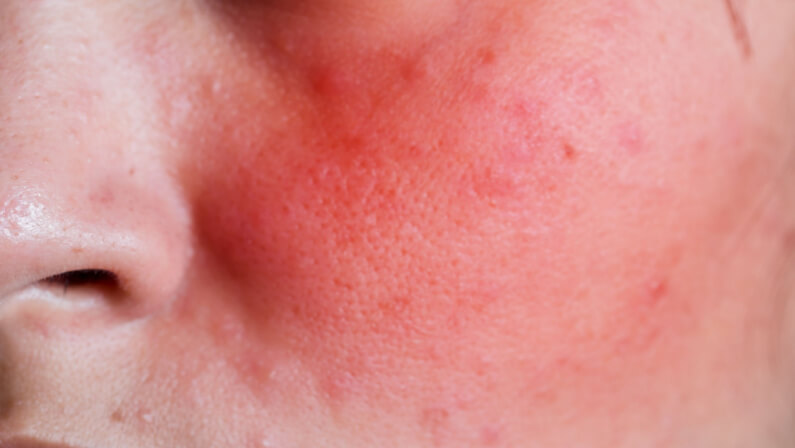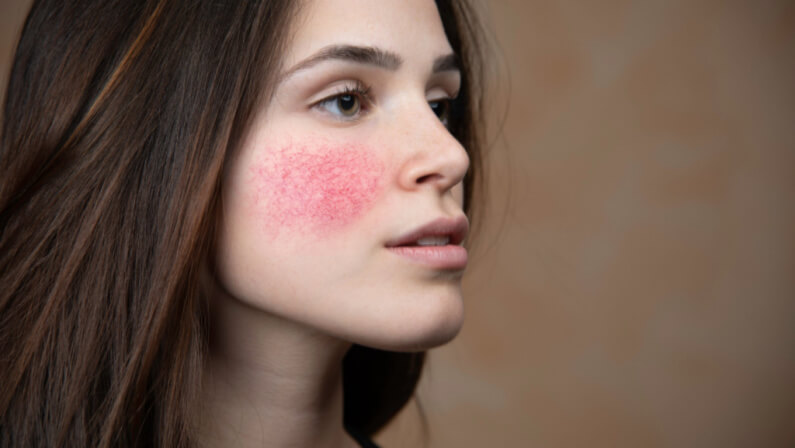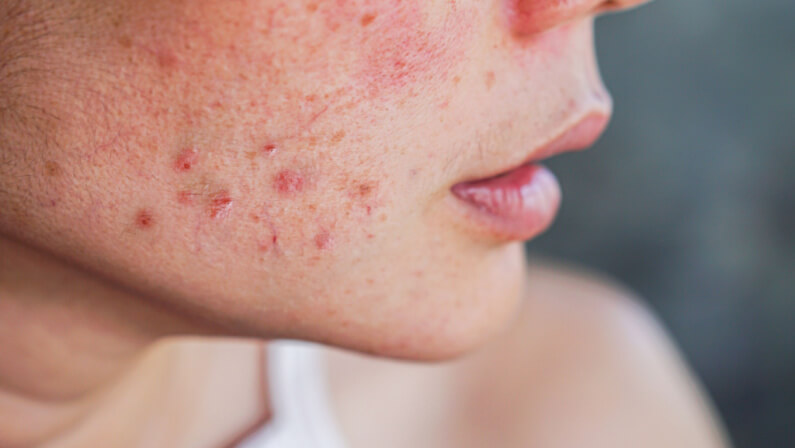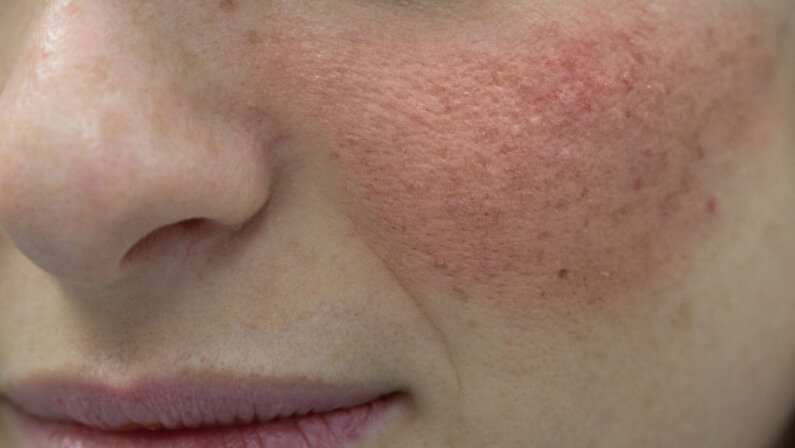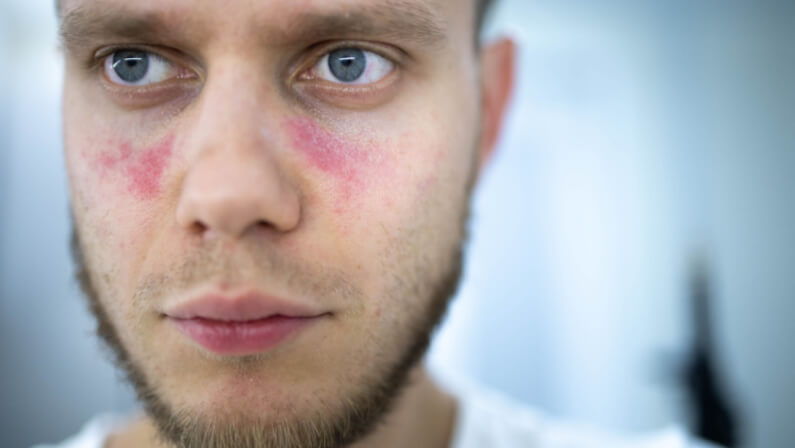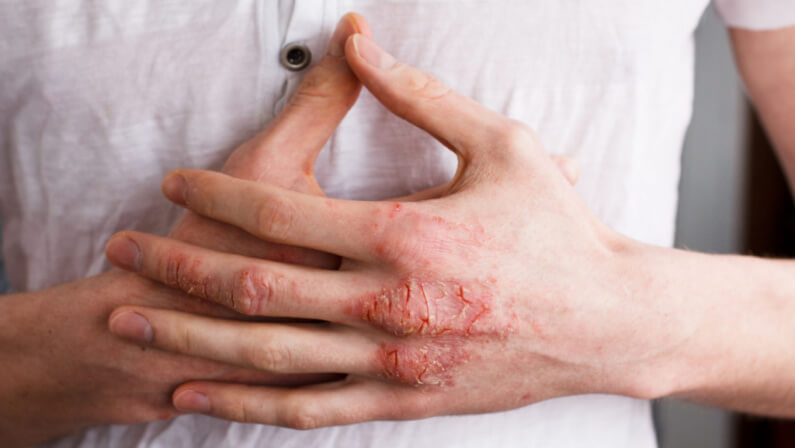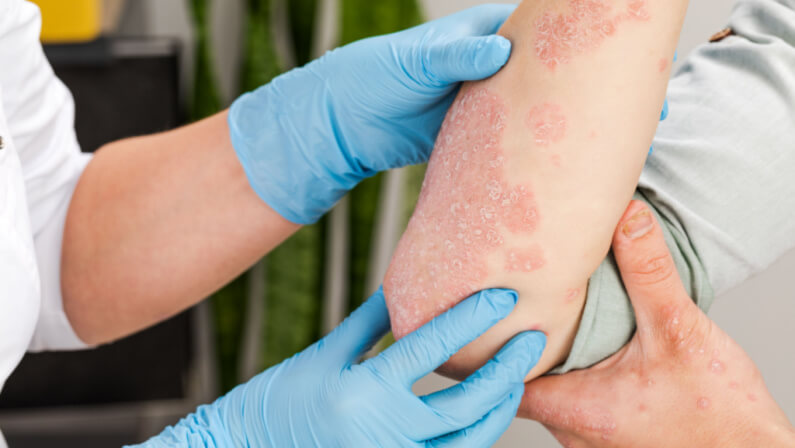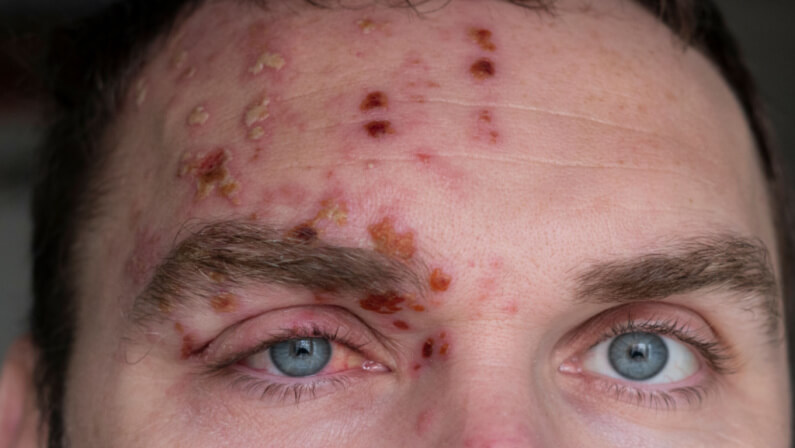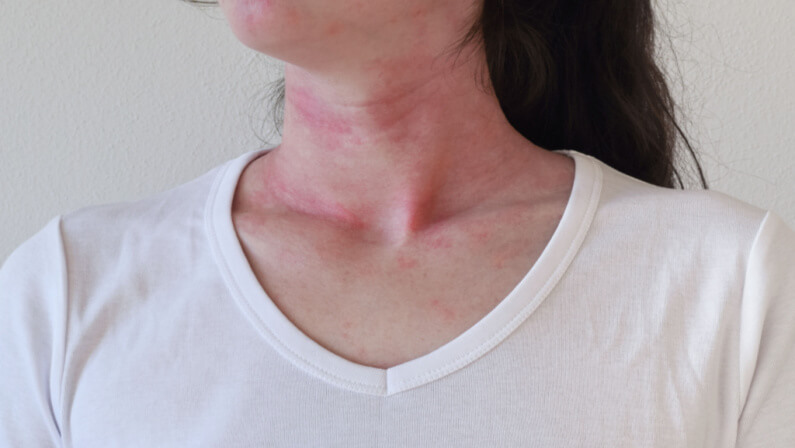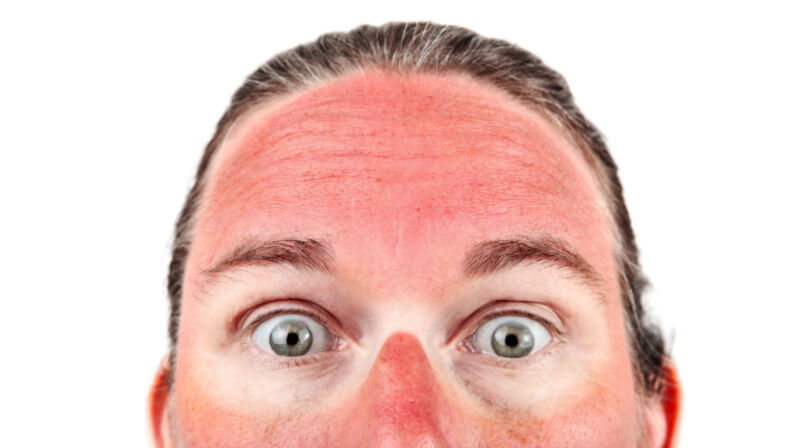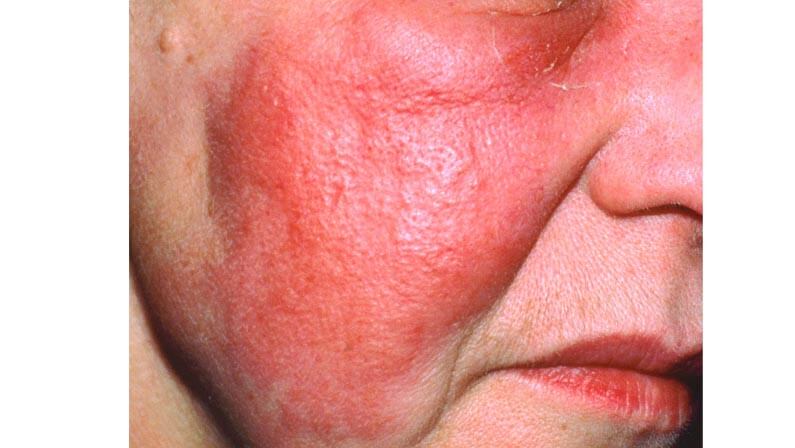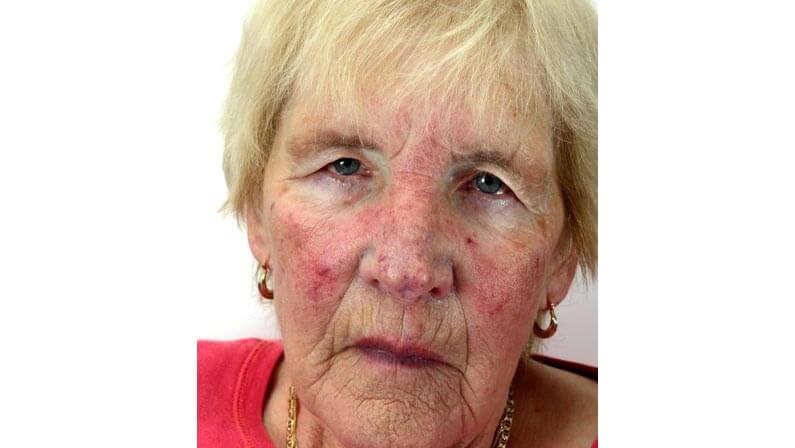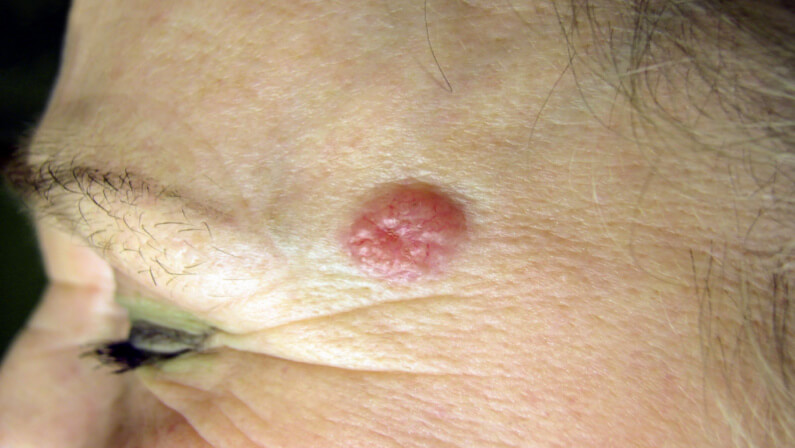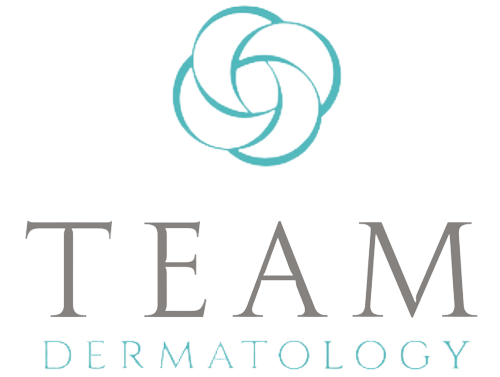Facial redness is an unwanted skin dilemma common among a lot of people.
If you have been dealing with a swollen, red face, you must know what causes it to come up with the proper treatment.
Knowing the exact cause and getting the proper treatment will help you regain your smooth and glowing skin.
Table of Contents
Why Is My Face Red?
Waking up one day with a red face is a distressing situation.
The redness can go from having swollen skin spots to spidery blood vessels scattered around the face. No matter what the reason is, these may seem scary and alarming at first glance.
The first thing you have to do is to remain calm. Panicking and overthinking will only stress you out and can further trigger some more redness.
You might also resort to instant DIY treatments, which is never a good idea. Rather than saving your skin, such a move can cause more harm than good.
Symptoms of facial redness
Not every skin condition evident in the face is considered facial redness. A small red spot can be a tiny scratch or a usual zit. However, the case is different in the redness becomes evidently dominant in the majority of the areas on the face.
Here are the common symptoms of facial redness that are easy to spot:
- blistering
- bumps
- itching
- burning
- flushing
- warmth in your skin
- sores
- hives
- swelling
- rash
Indications of facial redness also identify the severity of the skin condition. Team Dermatology can evaluate your skin’s state depending on your symptoms. Talk to their skin expert at any of their locations in Memorial and Sugar Land, Texas.
What causes facial redness?
Facial redness has a wide range of causes. A red and swelling face can be due to different health conditions affecting the skin’s health.
It is crucial to identify first what causes facial redness before your doctor decides on treatment.
Here are the most common causes of facial redness and what triggers them:
Rosacea
The most common reason for facial redness is rosacea—a chronic skin condition similar to adult acne.
According to a study, over 14 million people in the United States suffer from rosacea. It also tends to be more predominant among Caucasian people with fair skin.
Some of the triggers of rosacea flare-up are facial products with chemicals, abnormal reactions to blood vessels, sun exposure, lifestyle habits such as alcohol abuse, and poor diet.
Rosacea appears in the center of the face, particularly the nose and surrounding areas.
The symptoms of rosacea include:
- Small red pimples
- Find red vascular lines on the face
- An enlarged red nose with bulbous qualities
- Swollen eyelids
- Cornea inflammation
- Conjunctivitis or commonly known as pink eye
Acne
Acne is a common skin condition, and it affects all ages. The formation of acne starts when excess oil, bacteria, or dead skin cells block the pores. The body sends out red and white blood cells to fight infections due to the clogging of pores that presses against the skin. The result is a red pimple that is painful when touched.
Over 50 million Americans yearly suffer from acne every year. This skin disorder begins during the puberty stage. While acne usually disappears after this phase for some, many still have to deal with acne during adulthood. Several reasons linked to adult acne include hormonal fluctuations, medications for other diseases, pregnancy, hormonal therapy, and poor hygiene.
Seborrhea
Seborrhea, known as seborrheic dermatitis, are red, flaky patches that are itchy and irritating. When it develops on your scalp, it is considered dandruff. Seborrhea also appears in the chest, belly button, buttocks, under arms, and behind the knees.
This skin condition is prevalent among newborns and adults aging 30 to 60.
Seborrhea is usually caused by:
- Too much stress
- Genetic predisposition
- Yeast that thrives on the skin
- Existing medical conditions
- Cold and dry weather conditions
Lupus
Lupus is a rare chronic autoimmune disease affecting almost every body part. Aside from potential damage to the organs and joints, the skin also suffers.
When someone has lupus, the skin develops round, disc-shaped sores, usually on the face and scalp. Red scaly rash or red ring-shaped sores happen on the skin’s surface that gets sunlight, mainly the neck and arms. This condition is called discoid lupus.
In the US, over 16 000 people get lupus each year. Lupus is most common among women, although there are still cases among children, teens, and men.
Eczema
Eczema in the face presents dry, scaly, and itchiness. Over 10% of Americans suffer from eczema. At the onset, the facial skin redness also comes with cracked skin and appears as dry red and brown patches in the skin fold—often inside the elbows, behind the knees, and underarms. Eczema also appears on the face, neck, hands, or feet.
Atopic dermatitis refers to eczema among infants and children.
The cause of eczema is not exact, but it has links to genetic and environmental factors.
Factors that trigger eczema can be:
- Irritants found in soap, detergent, shampoo, and juices
- Certain foods such as citrus fruits, dairy products, and spices
- Hormonal fluctuations
- Extreme temperatures
Psoriasis
Psoriasis is another skin condition that results in facial skin redness. Although psoriasis may appear differently depending on the person, it usually presents dry and cracked skin, with red patches that come with a burning sensation.
Psoriasis can appear on the face as red patches, but it commonly surfaces on the lower back, elbows, knees, and legs.
Several factors can trigger psoriasis. These include:
- Cold weather
- Stress
- Smoking
- Too much alcohol intake
Shingles
Shingles are also known as herpes zoster. It is a skin condition that causes painful skin rashes in the body.
Shingles commonly appear in the torso and the face. Symptoms of shingles include pain, burning sensation when touched, red rash, and blisters with fluids. Fever and headache also come with having shingles.
The virus of shingles is called the varicella-zoster virus. It is the same as chickenpox. If you get chickenpox during childhood, the virus will not completely leave the body. It remains in some nerve cells and reactivates as shingles during adulthood.
Allergic Reaction
An allergic reaction, or contact dermatitis, also causes facial skin redness.
Over one out of five people in the US experience an allergic reaction. It shows red and itchy patches in the skin that triggers after exposure to a substance you have an allergy to. Bumps and blisters also appear on the skin minutes or hours after being triggered by the irritant.
Although allergic reaction is not life-threatening, they may cause you extreme discomfort.
The two types of allergic reactions are:
- Irritant contact dermatitis – occurs when a substance damages your skin’s protective layer.
- Allergic contact dermatitis – It happens when you come in contact with a substance you’re allergic to. Your immune system reacts to it by developing red sores.
Sun Exposure
A common reason why you may experience facial redness is sun exposure. The UV light from the sun destroys skin cells causing the immune system to react by increasing blood flow to the affected areas. The result of this is inflamed skin or sunburn.
Cellulitis
Cellulitis is a skin infection caused by bacteria. It results in swelling, pain, and redness in the infected area. The skin disease tends to be warm and tender when you touch it and can be painful if it is already severe. In some cases, people can have chills and fever.
Various bacteria cause cellulitis and penetrate the body through openings in the skin. It can enter through an injury, surgical wound, or scratches. Cellulitis is not contagious.
Carcinoid syndrome
Carcinoid syndrome results from the secretion of chemicals by a rare cancerous tumor called a carcinoid that occurs in the gastrointestinal tract or the lungs. The body reacts to these chemicals, causing blood vessels to dilate. When this happens, it shows effects such as bright red flushing of the face, neck, or upper chest and discomfort.
Basal cell carcinoma
One of the types of skin cancer is basal cell carcinoma which develops due to sun exposure. Since the face is one of the most exposed parts of the body, it creates red bumps and patches that often result in itchiness and discomfort.
Bumps can also appear pearly, shiny, and translucent with patches of brown, blue, and back within the areas affected. Basal cell carcinoma also appears with abnormal blood vessels spreading out within the face’s surface.
How to prevent facial redness
While various skin conditions cause facial redness, and you may need medications and treatment to prevent flare-ups, there are preventive ways to avoid the red sores.
These are the ways how to prevent facial skin redness:
- Keep your face clean. Wash your face regularly with a gentle cleanser.
- Avoid irritants. When you know what triggers your allergy, limit exposure to the substances. Always make sure to have your medication with you once symptoms appear.
- Get sun protection. A sunscreen will always be your best buddy when going out. Get a sunscreen that has an SPF of at least 15. Bring a hat or umbrella if going out under the scorching heat of the sun. On the other hand, do not underestimate cold weather as the sun’s rays can still penetrate clouds and damage your skin.
- Wear comfortable clothes. Consider dressing up with cool and more breathable clothes than tight-fitting ones.
- Stay hydrated. A natural way to keep your skin healthy is through hydration. Keep a bottle of water wherever you go so your skin can get the hydration it needs, even during hot temperatures.
Treatment for facial redness
The treatment for facial redness varies depending on your skin’s condition. Talk to a dermatologist to identify the proper treatment for your facial redness. These diseases can be detrimental to your health, so a consultation is a top priority.
- Rosacea. Avoid specific triggers like eating spicy food and smoking. Wear SPF cosmetics that offer sun-blocking protection without clogging pores.
- Acne. Follow a daily skin care regimen with gentle products on the skin. Avoid scrubbing facial products on the face and use them gently to prevent abrasions.
- Seborrhea. Seborrhea is a lifetime condition. Consistent medications for underlying conditions that cause seborrhea may lessen facial redness. You can also avoid flare-ups by having enough rest, exercise, a consistent skincare routine, and a stress-free outlook.
- Lupus. Lupus has no cure. However, if you get diagnosed with lupus early, you can prevent the effects it can bring to the skin, which involve facial redness. A rheumatologist knows how the proper medication for lupus.
- Eczema. Another untreatable skin condition is eczema, but creams and ointments are available to reduce flare-ups that come with it.
- Psoriasis. Psoriasis has no exact cure. Dermatologists treat the red patches in the body depending on the skin’s condition. It can be topical therapy, light therapy, or oral or injected medication. Flare-ups happen due to several triggers, such as cold weather. It is essential always to moisturize the skin and use a humidifier.
- Shingles. Shingles also do not have exact treatment. There are medications available to decrease the flare-ups and expedite the healing. If shingles appear on your face, you must contact your dermatology for early treatment to avoid developing permanent eye damage.
- Allergic Reaction. People with allergies need to avoid the substance they are allergic to. Take allergy medication as prescribed.
- Cellulitis. Antibiotics treat cellulitis. The medication is taken for five days. Intravenous (IV) antibiotics are also an option depending on the doctor’s assessment. Pain relievers also ease cellulitis, which may alleviate redness in the face.
- Carcinoid syndrome. Injections are used to reduce symptoms of carcinoid syndrome. It decreases skin flushing and other symptoms such as diarrhea.
- Basal cell carcinoma. Surgery removes basal cell carcinoma. A cancer specialist cuts out the lesion with cancer to prevent it from spreading. Upon surgical excision, facial skin redness may start to tone down.
Team Dermatology has a variety of tests to find out what causes your facial redness. If the diagnosis shows findings of a severe health condition, your doctor shall refer the specialists that are for the specific disorder. Set an appointment with a dermatologist to know about the next steps.
While waiting for your appointment date, you can start treating facial redness at home.
Consider these generally safe tips for treatment at home:
- Protect your skin from the sun. Always be mindful when going out of your house. Even when not under the sun’s scorching heat, UV rays can still damage your skin. Apply sunscreen and wear protective gear when going out.
- Maintain a healthy skin regimen. A consistent skincare routine is a must to keep your face clean and healthy. Keep your face clean all the time, and use moisturizers to keep your skin plump.
- Use gentle or recommended products: Use gentle cleansers for all skin types. There are available over-the-counter treatments you can use. However, it is always advisable to ask your dermatologist before applying it to your face.
Talk to a skin expert at Team Dermatology today and ask for recommendations for the best skin care products.
- Make lifestyle changes. The health of your skin lies in how you take care of your body in general. Ditch the poor diet, sedentary living, and lack of sleep and shift to a healthier lifestyle. Transform your lifestyle with a nutritious diet, regular exercise, and enough sleep, and see how your skin glow and look young.
- De-stress. When someone is stressed out, the skin becomes dry and saggy. Acne healing also slows down. Be mindful of your overall wellness and try to limit stressors that may affect your skin’s health.
Consult a dermatologist about facial redness
A proper approach can eliminate facial redness and achieve healthier skin.
So how do you rescue your skin from getting red? If you happen to develop sudden facial redness, consulting a dermatologist is the best way to deal with it.
You may have to undergo a series of tests for diagnosis and confirmation. The best way to know the next step is to talk to your dermatologist about your symptoms.
Dermatologists are experts in treating mild to moderate skin conditions. However, severe conditions that are caused by other underlying diseases such as cancer and lupus may need further referrals to other specialists.
Do you want to get rid of facial redness today? Book a consultation with a skin expert at Team Dermatology at any of their Memorial and Sugar Land, Texas locations.

